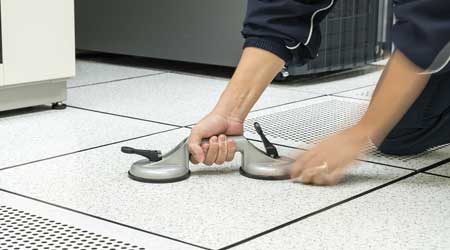Why Cold Aisle Air-Flow Management Works
Understanding the assumptions that make cold-aisle monitoring work is important to ensure the strategy is successful.
Before describing this strategy of monitoring loads by cold aisle, it’s important to explain the assumptions that make this strategy work. This strategy assumes a starting point of an uncontained data hall with a raised floor delivery of cooling air through perforated tiles or grates, and constant volume computer room air handling/computer room air conditioning units. This may not look like today’s more sophisticated data centers, but remember that this strategy applies to older, legacy facilities that have not been upgraded.
The IT equipment draws air from one aisle, heats it up through its own internal processes, and discharges hot air to the other aisle. The IT equipment determines what temperature rise will occur, which may depend on entering air temperatures, work load, and perhaps many other factors beyond the control of the data hall’s cooling system.
The IT equipment will “consume” chilled air, and that cooling air will find its way to the IT equipment following the path of least resistance. When air is consumed by the IT equipment, air from the cold aisle will move into the area of the IT equipment to replace the air that has been consumed by the IT equipment. Air does not need to be “thrown” at the IT equipment.
If there is not enough cold air in the cold aisle to replace the consumed air, air from the hot aisle will migrate to the cold aisle (around the cabinets or over the tops of the cabinets) to replace the consumed air. The best way to prevent this problem — known as recirculation air — is to make certain sufficient supply air is provided into the cold aisle.
Supply air needs to be provided into the cold aisle at low velocity. This seems counter-intuitive because, as more heat is generated by the IT equipment, more air is needed. Introducing air into the cold aisle at a high velocity risks having the cooling air miss the servers completely and being “thrown” out of the aisle. If cold air is thrown out of the cold aisle, the nearest available source of air is usually an adjacent hot aisle.
When more air is needed in a cold aisle, do not increase the air flow through each tile; instead, increase the number of floor tiles. Use one type of floor grille across an entire data hall. Mixing perforated tiles (about 25 percent free area) with grates (about 50 percent or more free area) does not improve air flow. Perforated tiles work better with higher underfloor pressures, whereas grates work better at lower pressures. Placing a grate in a field of perfs will guarantee that all the air from the grate will flow out the top of that cold aisle. Conversely, use grates when higher IT equipment densities are expected, but do lower the underfloor pressure to prevent the loss of air out the top of the aisle. Placing a perf tile in a field of grates at lower pressure will guarantee that the perf tile provides insufficient air to the cold aisle.
Vali Sorell (vsorell@glumac.com) is vice president and chief mission critical mechanical engineer at Glumac. He has 35 years of design experience, the last 20 of which have been dedicated to mission critical projects.
Related Topics:














